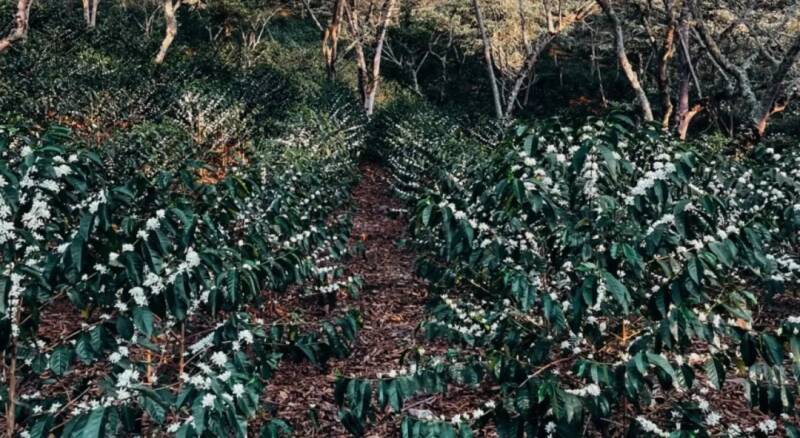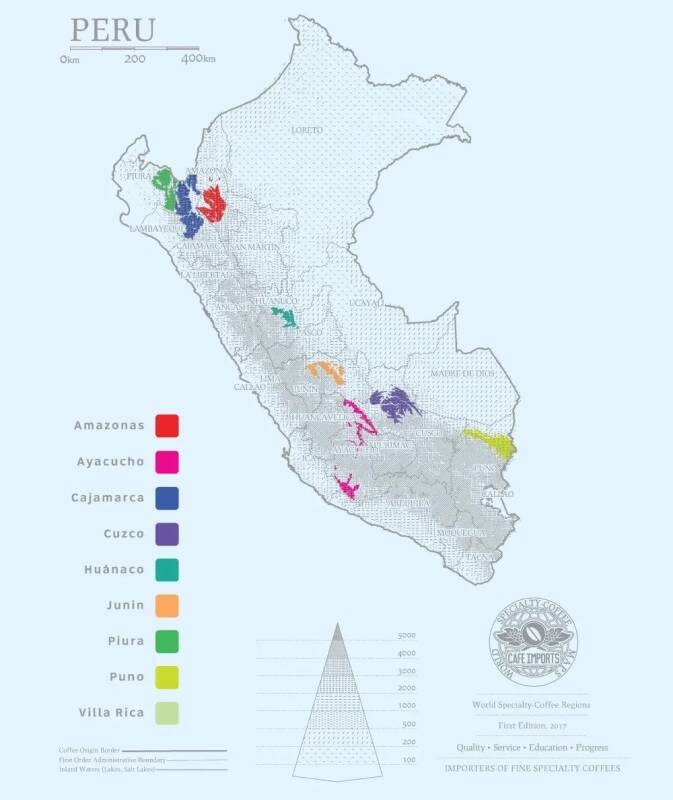Introduction to Cajamarca, a coffee producing area in Peru, South America
In South America, there are volcanic soil and Andes, the climate is warm and humid, the rainfall is abundant, the climate is mainly tropical, and the growth conditions are very suitable for growing coffee, so there are many coffee producing countries, such as Colombia, Brazil, Peru and other countries. Among them, Peru is relatively low-key, but because of good mountains and good water, it can also produce good quality coffee beans.
Coffee came to Peru in the 18th century, but most of the coffee produced in Peru is for domestic consumption, so it is rarely exported. Until the end of the 19th century, when coffee leaf rust hit Indonesia, which was a major supplier of coffee in Europe, Europeans were looking for a new source of coffee, at a time when Peru owed loans to the British government. became an ideal new place to grow.
After two world wars, the big European countries began to sell their land in the Americas, and the land recovered by the Peruvian government was redistributed to the locals, from a large manor to small-scale farming. But after that, the government clashed with the Shining Road guerrillas, and the violence lasted for more than a decade, affecting local farmers and did not return to normal until 1992. By the mid and late 1990s, international coffee brands focused on buying coffee that met quality, economic, social and environmental performance standards, a move that contributed to the revival of Peruvian coffee production and made Peru one of the largest producers of organic coffee in the world.

Coffee grows well in Peru because of the country's topography and climate. Peru is located in western South America, with the Andes mountains stretching north and south, with mountains accounting for 1/3 of the country's area. The whole territory is divided into three regions from west to east. The western coastal area is an arid plain and also a tropical desert area, but irrigated agriculture is well developed. the central mountain plateau is mainly the middle part of the Andes, and the central and southern part is volcanic, with an average elevation of about 4300 meters. It is also the birthplace of the Amazon River, and the east is the Amazon rainforest region.
Peru is located in the tropics, but due to complex geographical conditions, the climate is also relatively diverse. Peru has 28 different climates. Coffee is mainly grown in the central Andes, because it is located on the plateau and has a tropical mountain climate. It is rainy in summer, and the temperature and humidity will decrease with the increase of altitude.

Peru is mainly divided into three coffee producing areas in the north, central and south, and is planted at an altitude of 1000-1800 meters. Among them, the coffee planting area in the north is 43% of the country in Peru, and the northern producing area of Cajamarca Cajamarca is more famous in recent years.
The Cajamarca region of Cajamarca is located in northern Peru, near the Ecuadorian border, high in the Andes. The area has a variety of landscapes, ranging from 1500 meters to 2600 meters above sea level, providing ideal conditions for coffee cultivation.
Here, basically small farmers with an area of 1 to 10 hectares grow coffee crops using traditional and sustainable farming methods, usually intercropping with other plants such as bananas, avocados and corn, which helps to maintain soil fertility and form the unique flavor characteristics of coffee beans. And farms in the region appear on the COE list all the year round, such as the 2023 champion Yoniser Mego Silva Farm.
Yoniser Mego Silva Farm, managed by Alto Mirador and his family, is located in Hahn City, Cajamarca District, and is planted up to 1990 meters above sea level. The farm was bought in 2000 as a traditional coffee plantation with Caturra, Typica, etc., and the estate was expanded to start planting rose varieties in 2020, before entering the COE competition in 2022, the second time in 2023, and winning the championship with a Rose Summer score of 90.74 points.
Important Notice :
前街咖啡 FrontStreet Coffee has moved to new addredd:
FrontStreet Coffee Address: 315,Donghua East Road,GuangZhou
Tel:020 38364473
- Prev

Is the Starbucks sandwich meat slices abnormal? Netizen: It's hard to say!
▲ Click to pay attention| Daily boutique coffee culture magazine coffee workshop coffee with a sandwich should be the choice of many migrant workers when settling their own meal. This is the case for a certain Starbucks user. Recently, as usual, she placed an order for Starbucks takeout through a third-party platform and ordered a sandwich she often eats.
- Next

What is the difference between the safety filter cup and the V60? Will the wooden filter cup taste wood when washed out? How to make deep-roasted coffee beans?
Today, while Qianjie was sorting out a small corner of the store, he found a special but very niche filter cup. Although this passage sounds very niche, it is the case! The name of this filter cup is "Anqing Filter Cup" and it is produced by the well-known Yamanaka Lacquer Wood Factory in Kaga, Japan. So today, Qianjie will come to divide it
Related
- Customers have "changed" Manner's new products! Shop assistant: Please don't mess around!
- Remove sockets in customer areas at Starbucks stores?! Netizen: I won't go if I really tear it down
- What is the difference between the taste steps of sun-dried coffee and washed coffee? Why is sun-cured coffee sweeter and washed coffee sour?
- The recipe for salty grapefruit dirty is revealed! Coffee Festival salty grapefruit dirty coffee making materials parameters ratio milk share!
- How about the flavor of Sunlight 74158 at Sidamo Banshaha Mathieu Processing Factory in Ethiopia? 74158 Share the proportion of coffee brewing parameters!
- What effect does Italian American coffee with filter paper have? Will coffee taste better if it is put on filter paper at the bottom of the powder bowl?
- What is the color difference in coffee beans? What are the characteristics of honey processed coffee beans? Why are the anaerobically treated coffee beans uneven in color?
- How does novice Xiaobai quickly get started and make coffee? Newbies learn to make coffee by hand and share the specific steps and process process!
- Costa tea has a shelf life of 100 years?! Expert: Unable to verify
- It's a huge uproar! American milk addition was rejected by Manner employees?!

